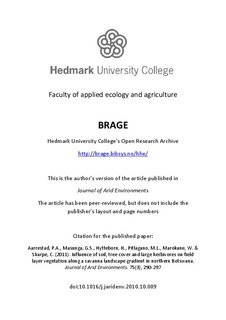Influence of soil, tree cover and large herbivores on field layer vegetation along a savanna landscape gradient in northern Botswana
Journal article, Peer reviewed
Permanent lenke
http://hdl.handle.net/11250/134342Utgivelsesdato
2011Metadata
Vis full innførselSamlinger
Originalversjon
Aarrestad, P.A., Masunga, G.S., Hytteborn, H., Pitlagano, M.L., Marokane, W. & Skarpe, C. (2011). Influence of soil, tree cover and large herbivores on field layer vegetation along a savanna landscape gradient in northern Botswana. Journal of Arid Environments. 75(3), 290-297 10.1016/j.jaridenv.2010.10.009Sammendrag
The response of the field layer vegetation to co-varying resource availability (soil nutrients, light) and resource loss (herbivory pressure) was investigated along a landscape gradient highly influenced by elephants and smaller ungulates at the Chobe River front in Botswana. TWINSPAN classification was used to identify plant communities. Detrended Correspondence Analysis (DCA) and Canonical Correspondence Analysis (CCA) were used to explore the vegetationeenvironment relationships. Four plant communities were described: Panicum maximum woodland, Tribulus terrestris woodland/shrubland, Chloris virgata shrubland and Cynodon dactylon floodplain. Plant height, species richness and diversity decreased with increasing resource availability and resource loss. The species composition was mainly explained by differences in soil resources, followed by variables related to light availability (woody cover) and herbivory, and by interactions between these variables. The vegetation structure and species richness, on the other hand, followed the general theories of vegetation responses to herbivory more closely than resource related theories. The results suggest a strong interaction between resource availability and herbivory in their influence on the composition, species richness and structure of the plant communities.
